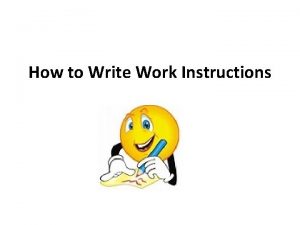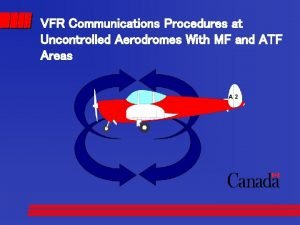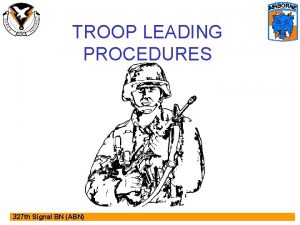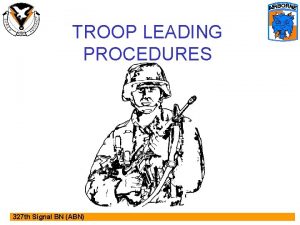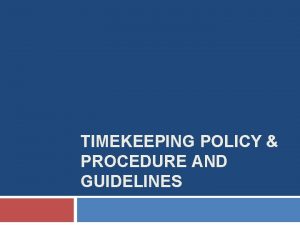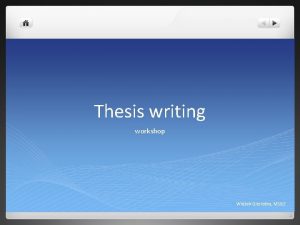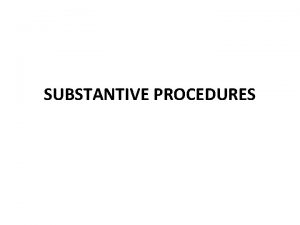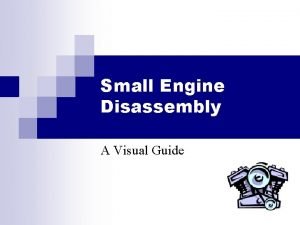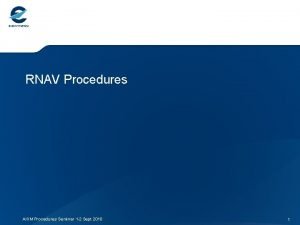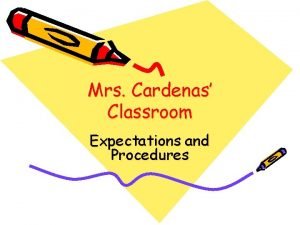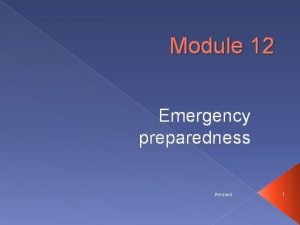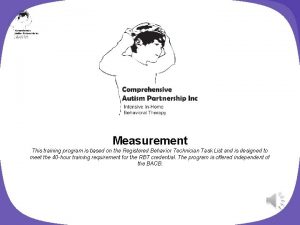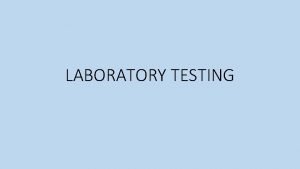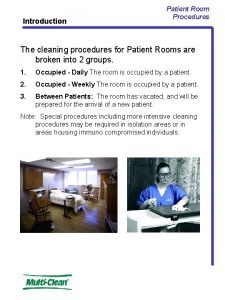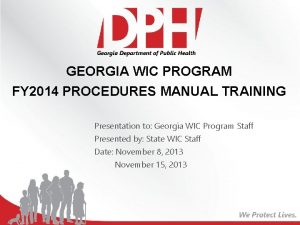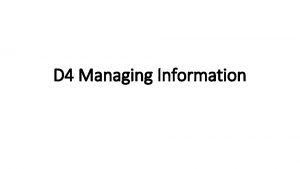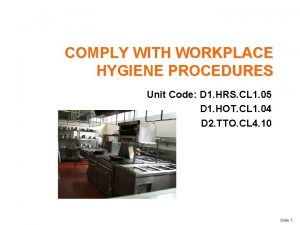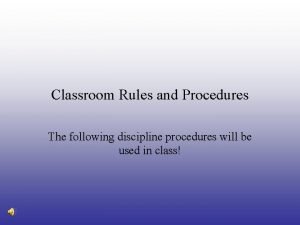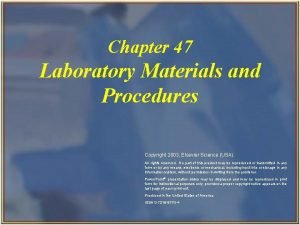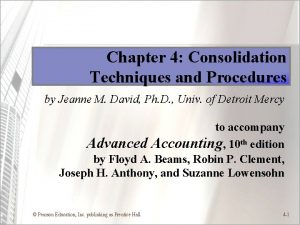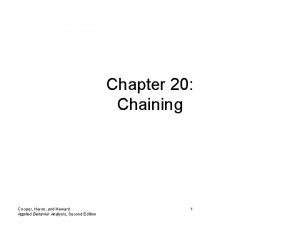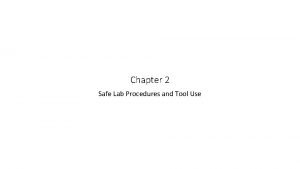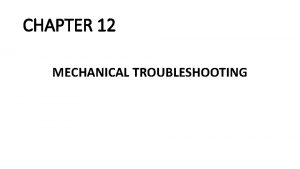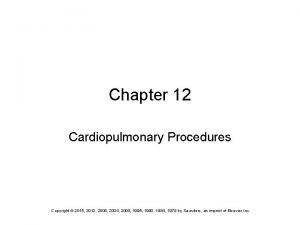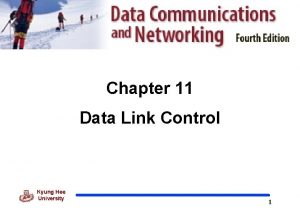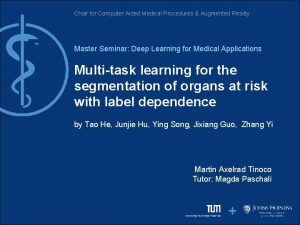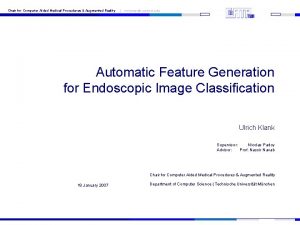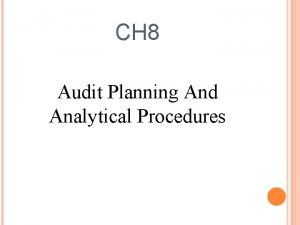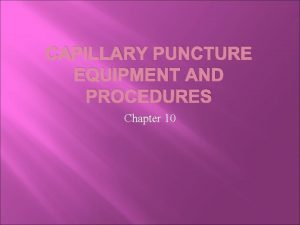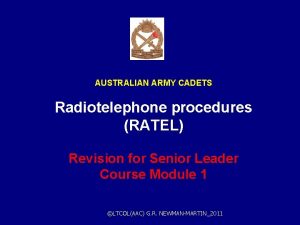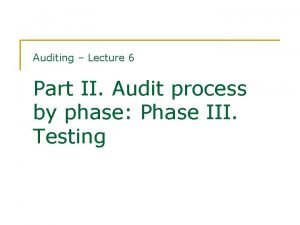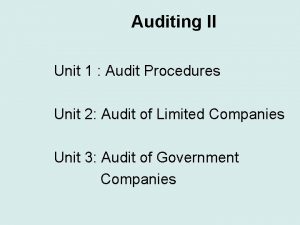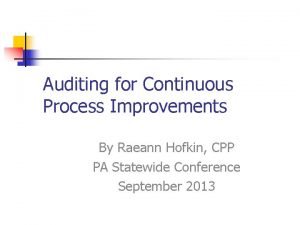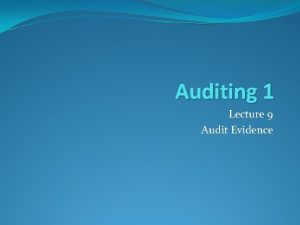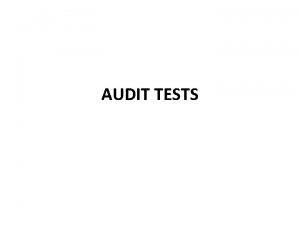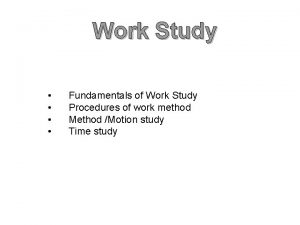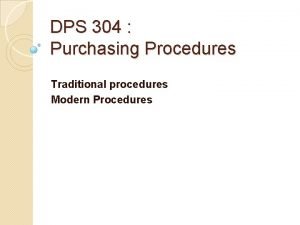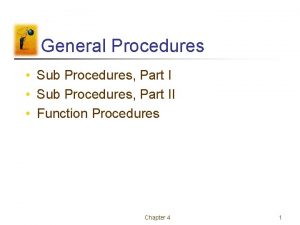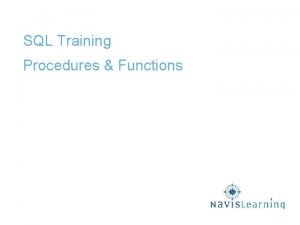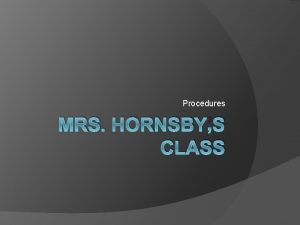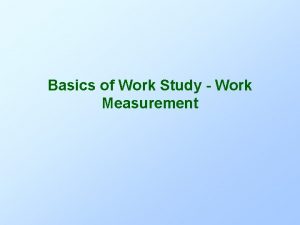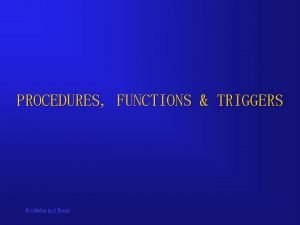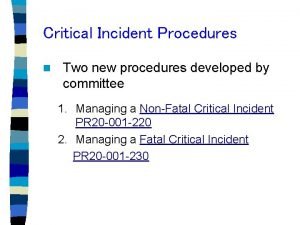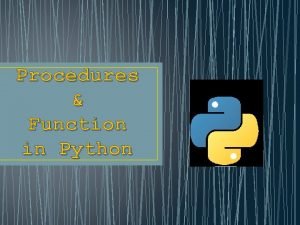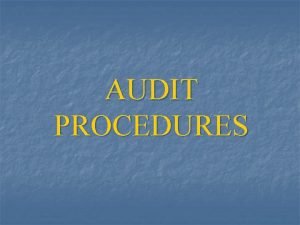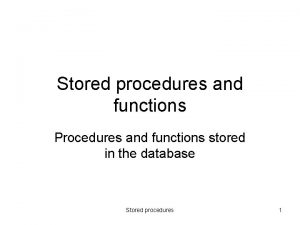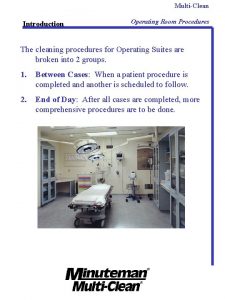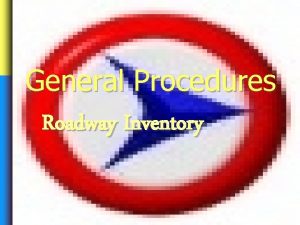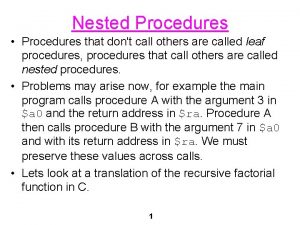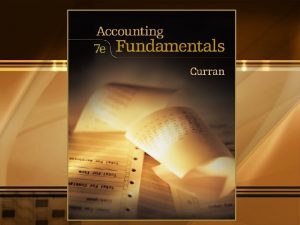Work Study Fundamentals of Work Study Procedures of


















































- Slides: 50

Work Study • • Fundamentals of Work Study Procedures of work method Method /Motion study Time study

Work Study Definition q Study on works done by human q Systematic study to find the most efficient work method and set standard for performances q Management method including 1. Method Study 2. Work measurement

Work Study Objective Ø Ø Ø Standardized method on doing work Standard Time Minimize Production Cost Less of material and workers movement Elimination of unproductive movement Ensure efficiency on human, tools and material utilization

Work Study The systematic examination of the methods on carrying an activities so as to improve the effective use of the resources and to set up standard of performances for the activities being carried out Method Study (motion study) Systematic recording and critical examinations of ways of doing things in order to make improvement Work Study Work Measurement (time study) HIGHER PRODUCTIVITY Applications of techniques design to establish the time for a qualified worker to carry a task at a defined rate of working OUTPUT INPUT

Basic Procedure of Work method Select the job or process to be studied Record the relevant facts about the job by direct observation and collect such additional data as may be needed from appropriate sources. Examine the record critically and challenge everything that being done (its purpose, place sequence and method of performance. ) Develop the most practical, economics and effective method Evaluate different alternatives to developing a new improved method comparing the cost-effectiveness of the selected new method with the current method of performance. Define the new method and the related time with documentation and present to those concerned; ie supervisors, workers, management Install the new method, training those involved Maintain the standard practice by monitoring the results and introduce control procedures to prevent a drifting back to the previous method of work.

Select A job is selected such that the proposed method achieves one or more of the following results • (a) Improvement in quality with lesser scrap. • (b) Increased production through better utilization of resources. • (c) Elimination of unnecessary operations and movements. • (d) Improved layout leading to smooth flow of material and a balanced production line. • (e) Improved working conditions. Based on 3 Factors Ø Economic – involving improvement of all the sources such as time, capital and human energy that can contribute to company profit Ø Technical – Consideration taken based on if involving change will effect the quality of product cause of limitation on technical property Ø Human – Is it going to affect the way in which the job is done presently and is not fully accepted by workman and the union

Record » Must be accurate and based on description of actual situation » Use CHARTS & DIAGRAMS Records Techniques Charts Macro Motion Chart Diagrams Movement Micro Motion Chart • Operation Process Chart • SIMO chart • Flow Process Chart • Therblig • Two Handed Process Chart • Multiple Activity Chart • Flow • String

Record: Macro Charts Operation Process Chart • Also called outline process chart • recording only the major activities and inspections involved in the process. • uses only two symbols, i. e. , operation and inspection

Record: Macro Charts Flow Process Chart • gives the sequence of flow of work of a product or any part of it through the work centre or the department recording the events using appropriate symbols • operations; inspection, storage, delay and transportation are represented • three types (a) Material type—Which shows the events that occur to the materials. (b) Man type—Activities performed by the man. (c) Equipment type—How equipment is used. • The flow process chart is useful: (a) to reduce the distance travelled by men (or materials). (b) to avoid waiting time and unnecessary delays. (c) to reduce the cycle time by combining or eliminating operations. (d) to fix up the sequence of operations. (e) to relocate the inspection stages.

Record: Macro Charts Two Handed Process Chart • most detailed type of flow chart in which the activities of the workers hands are recorded in relation to one another • work carried out at a single workplace • Use 4 symbols: Ø Ø Operations Transportation Delays Storage

Record: Macro Charts Multiple Activity Chart • activities of more than subject (worker or equipment) are each recorded on a common time scale to show their inter-relationship • Multiple activity chart is made Ø to study idle time of the man and machines, Ø to determine number of machines handled by one operator, and Ø to determine number of operators required in teamwork to perform the given job Purpose: To study the different layout plans and thereby; select the most optimal layout. To study traffic and frequency over different routes of the plant. Identification of back tracking and obstacles during movements.

Example Figure : Flow Process Chart Figure : Two handed/ Right. Hand Left-Hand

Record: Diagrams Flow Diagram • Drawing of the working area, showing the location of the various activities identified by their numbered symbols • Associated with particular flow process chart either man type or machine type. • Routes followed in transport are shown by joining the symbols in sequence by a line which represents as nearly as possible the path or movement of the subject concerned • Procedures: 1. The layout of the workplace is drawn to scale. 2. Relative positions of the machine tools, work benches, storage, and inspection benches are marked on the scale. 3. Path followed by the subject under study is tracked by drawing lines. 4. Each movement is serially numbered and indicated by arrow for direction. 5. Different colours are used to denote different types of movements.


Record: Diagrams String Diagram • • • A scale layout drawing on which, length of a string is used to record the extent as well as the pattern of movement of a worker working within a limited area during a certain period of time. Purpose: to produce a record of a existing set of conditions so that the job of seeing what is actually taking place is made as simple as possible Procedures: 1. A layout of the work place of factory is drawn to scale on the soft board. 2. Pins are fixed into boards to mark the locations of work stations, pins are also driven at the turning points of the routes. 3. A measured length of the thread is taken to trace the movements (path). 4. The distance covered by the object is obtained by measuring the remaining part of the thread and subtracting it from original length.


Method Study Graphical method of recording originated by Gilbreth Consists of symbols to represent process, methods or procedure Symbols: 1. O = operation 2. □ = inspection 3. →= transportation 4. D = delay 5. ▽ = storage

Motion Study Motion study is part of method study where analysis of the motion of an operator or work will be studied by following the prescribed methods. Principles of Motion study The principles are grouped into three headings: (a) Use of the human body. (b) Arrangement of workplace. (c) Design of tools and equipment.

(A) USES OF HUMAN BODY When possible: 1. The two hands should begin and complete their movements at the same time. 2. The two hands should not be idle at the same time except during periods of rest. 3. Motions of the arms should be made simultaneously. 4. Hand body motions should be made at the lowest classification at which it is possible to do the work satisfactorily. 5. Momentum should be employed to help the worker, but should be reduced to a minimum whenever it has to be overcome by muscular effort. 6. Continuous curved movements are to be preferred to straight line motions involving sudden and changes in directions. 7. ‘Ballistic’ (i. e. , free swinging) movements are faster, easier and more accurate than restricted or controlled movements. 8. Rhythm is essential to the smooth and automatic performance of a repetitive operation. The work should be arranged to permit easy and natural rhythm wherever possible. 9. Work should be arranged so that eye movements are confined to a comfortable area, without the need for frequent changes of focus.

(B) ARRANGEMENT OF THE WORKPLACE 1. Definite and fixed stations should be provided for all tools and materials to permit habit formation. 2. Tools and materials should be pre-positioned to reduce searching. 3. Gravity fed, bins and containers should be used to deliver the materials as close to the point of use as possible. 4. Tools, materials and controls should be located within a maximum working area and as near to the worker as possible. 5. Materials and tools should be arranged to permit the best sequence of motions. 6. ‘Drop deliveries’ or ejectors should be used wherever possible, so that the operative does not have to use his hands to dispose of finished parts. 7. Provision should be made for adequate lightning, and a chair of type and height to permit good posture should be provided. The height of the workplace and seat should be arranged to allow alternate standing and seating.

(C) DESIGN OF TOOLS AND EQUIPMENTS 1. The colour of the workplace should contrast with that of work and thus reduce eye fatigue. 2. The hands should be relieved of all work of ‘holding’ the work piece where this can be done by a jig or fixture or foot operated device. 3. Two or more tools should be combined where possible. 4. Where each finger performs some specific movement, as in typewriting, the load should be distributed in accordance with the inherent capacities of the fingers. 5. Handles such as those used on screw drivers and cranks should be designed to permit maximum surface of the hand to come in contact with the handle. 6. Levers, cross bars and wheel bars should be in such position that operator can manipulate them with least body change and with greatest mechanical advantage.

1. Operation O An operation occurs when an object is intentionally changed in one or more of its characteristics (physical or chemical). This indicates the main steps in a process, method or procedure. An operation always takes the object one stage ahead towards completion. Examples of operation are: • Turning, drilling, milling, etc. • A chemical reaction. • Welding, brazing and riveting. • Lifting, loading, unloading. • Getting instructions from supervisor. • Taking dictation. 2. Inspection □ An inspection occurs when an object is examined and compared with standard for quality and quantity. The inspection examples are: • Visual observations for finish. • Count of quantity of incoming material. • Checking the dimensions.

3. Transportation → A transport indicates the movement of workers, materials or equipment from one place to another. Examples: • Movement of materials from one work station to another. • Workers travelling to bring tools. 4. Delay D: Delay (Temporary Storage) A delay occurs when the immediate performance of the next planned thing does not take place. Example: • Work waiting between consecutive operations. • Workers waiting at tool cribs. • Operators waiting for instructions from supervisor. 5. Storage ∇ Storage occurs when the object is kept in an authorized custody and registered. For example, materials kept in stores to be distributed to various work.

Quiz Develop a Process Chart for drilling a 10 mm diameter hole on a metal workpiece Steps: 1. Draft out the entire process 2. Decide the type of process 3. Determine if any distance involved

Activity: 1. Mark the measurement of the hole onto the work piece 2. Hammer and indenter on shelf 3. Reach for hammer and indenter 4. Make an indentation to guide the drill bit 5. Carry to drilling machine 6. Drill bit set on shelf 7. Select appropriate drill bit 8. Insert drill bit to spindle 9. Tighten the chuck 10. Rotate the chuck by hand to confirm that the drill bit is inserted properly and not wobbling. 11. Clamp the work piece securely 12. Ensure safety measures: close down the protective lid, wear appropriate PPE 13. Perform drilling 14. Inspect for burrs 15. Files set on shelf 16. Reach for files 17. Perform filing 18. Carry tools back to shelf

Example Develop a Multiple Activity Chart for doing three loads of laundry, assume you will have access to one washing machine and one dryer.

Examine Study all the record and identified problems/weakness exist. Find alternatives. Question: WHAT & WHY WHO & WHY WHERE & WHY WHEN & WHY HOW & WHY Improvement can be achieve: Elimination Combination Rearrangement Simplification

Work Study examine elimination Ø All possible activities, jobs or motion combination Ø Combine the multiple activities/elements rearrangement Ø Improvement by rearrangement process/works simplification Ø Analysis each of the operation on process for simplification or improvement

Work Study develop the most practical, economics and effective method Development » : of alternatives based on principles: §Single Minute Exchange of Die SMED) § Design for Manufacture & Assembly (DFMA)

Work Study Evaluate define Involve 2 Aspect 1. • All the alternative efficiency need to be 2. measure and evaluate so the decision can be carry out based on TIME STUDY Report of Method implications q Cost, Savings and Action taken. Standard Operation Procedure (SOP) q For the new Method q References, Explanation and guideline on workers training. q Standard Practice explain tools, works method and work station layout.

Work Study install Divide on 3 section a. b. c. Approval and support from manager, supervisors & workers Trained workers with new method utilization Monitor all the development until achieve the original target maintain Maintain the new method as being fixed and all the workers not allowed to use the old method

Work Measurement/ Time Study DEFINITION Ø Application of the techniques designed to establish the time for a qualified worker to carry out a task at a defined rate of working OBJECTIVE Ø INVESTIGATING , REDUCING AND SUBSEQUENTLY ELIMININATING INEFFECTIVE TIME ( TIME DURING NO EFFECTIVE WORK IS BEING PERFORMED, WHATEVER THE CAUSE)

The Uses of Work measurement ü Compare the efficiency of alternatives methods ü Balance the work of the member teams ü To determine in association with the worker and machine multiple activity chart, the number of machine and operative can run ü To provide the basis for production planning and control for the choice of better layout and for process planning and establishing just-in-time and inventory control system ü To provide information that can enable estimates to be made for tenders, selling prices and delivery dates ü To set standards of machine utilization and labor performance that can be used for any of the above purposes and as basis in incentives scheme ü To provide information for labor cost control and to enable standard costs to be fixed and maintained

Techniques of Work measurement Select, record, examine and measure quantity of work performed using either one of a combination of following method Work Sampling Structured Estimating Predetermined Time Study Compile With appropriate allowances to get started time of operations To establish standard data bank

Definitions in time study Normal time the time required for an average, trained operator to perform a task under usual working condition and working at normal pace. (It not include allowances for personal needs and delays that would be necessary if the task were done 8 hours ) Normal pace the pace of an average, trained and conscientious operator working over Actual time an 8 hour- day the observed time required for an operator to perform task allowances the amount of time added to the normal time to provide for personal needs, unavoidable delays and fatigue. Standard time the total time in which the a job should be completed at a standard performances

method of determining standard times v DIRECT TIME STUDY v TIME STUDY STANDARD DATA v PREDETERMINED TIME SYSTEMS v PREDETERMINED MOTION TIME STUDY v WORK SAMPLING

v. DIRECT TIME STUDY Ø Work measurement techniques in which a physical measurement is made of the actual time required to do a task by using a watch or some other device. Ø Tools: § Watch ( Stop watch ) § Time Study Form § Observation Board Ø Stop Watch Method § Continuous Timing – Unstopping time recorded § Repetitive Timing (Snap back) – The indicator of top watch back to zero for each work element end.

v. DIRECT TIME STUDY Ø PROCEDURE § Collect and record all the information related to work and work situation § Divided work that are studied into the elements with the description § Fixed observation quantity using statistical method and assumption § Do the observation and record the time taken by worker for each elements and rating for each worker § Define worker allowance § Calculate Standard time

v. DIRECT TIME STUDY q Average Time = Total Time Quantity of Observation Average Time x Rating % q Normal Time = q Standard Time = Normal Time + ( Normal Time x Allowances %) @ Normal Time x ( 100 / 100 - Allowances %)

v. DIRECT TIME STUDY Observation of 4 cycle Allowance 5% from Normal Time Qty Work elements Cycle 1 Cycle 2 Cycle 3 Cycle 4 Rating for workers 90% 1 Take the cloth 25 30 35 25 Work days per week = 6 2 Put in the washing machine 8 9 8 6 Method 3 Switch on and machine operation 10 10 • 4 Take out the cloth 8 8 9 6 Data from stop watch snap back Calculate i. Average Process Time ii. Normal Process Time iii. Standard Process Time iv. How many trip of washing cloth can be done if working hours = 8 hour for one week v. If salary is = RM 1. 50/hour what is labor cost for each trip

v. DIRECT TIME STUDY Qty Work elements Average Time Normal Time Standard Time 28. 8 25. 9 27. 2 1 Take the cloth 2 Put in the washing machine 7. 8 7 7. 4 3 Switch on and machine operation 10 9 9. 5 4 Take out the cloth 7. 8 7 7. 4 Standard Time : 51. 5 b) 6 x 8 x 60 / 51. 5 = 3355. 34 = 3355 trip c) 51. 5 x 1. 5 / 60 x 60 = RM 0. 02/trip

Assignment #1 Assuming that the total observed time for an operator to assemble a toy truck is 1. 00 min. If the rating is 120%, find normal time. If an allowance of 10% is allowed for the operation, determine the standard time.

v. Work sampling Ø Method of finding percentage occurrence of a certain activity by statistical sampling and random observation Ø In order to obtain a complete and accurate picture of the productive time and idle time of the machine, production area or operator. § Example : making a tours of the factory at random intervals noting which machine are working and which are stopped and noting the cause of stoppage.

v. Work sampling Ø PROCEDURE § Identified study objective ü Things that needs to be achieve after the study ü Such as the percentage rating of operators or machine either productive, busy or idle § Do the early observation ü Randomize based on experience for estimation percentage idle time and productive time § Decide quantity of observations ü Based on confidence level and accuracy range chosen from statistical method or nomogram § Decide frequency of observations ü Random Number Table § Do the observation and record on observation form prepared for this study objective

v. Predetermined time MOTION STUDY • A work measurement technique whereby times established for basic human motions (classified according to the nature of the motion and conditions under which it is made) are used to build up the time for a job at the defined level ofperformance. The most commonly used PMTS is known as Methods Time Measurement (MTM).

v. Predetermined time MOTION STUDY Ø PROCEDURE § Jobs or task are broken down into finer and finer elements § Time values can be assigned to these elements § The total time required to perform a task can be determined by adding the appropriates elements

v. Predetermined time MOTION STUDY Ø Example § Using MTM systems to identify standard time § 1 TMU = 0. 0006 minutes § Data must be extremely accurate, more decimals places are necessary

v. Predetermined time MOTION STUDY Ø § Example One Printed circuit board needed semiconductor to be push in the drilled groove. Movement elements involve: I. III. IV. V. VI. Hand move 6 inch to semiconductor Grasp semiconductor Bring semiconductor to the board Adjust the position of semiconductor Push in the groove Put the board aside TOTAL 1 TMU = 0. 0006 minutes 84. 2 TMU = 84. 2 ( 0. 0006) = 0. 05052 minutes = 3. 0312 second 10. 5 TMU 8. 0 TMU 9. 5 TMU 20. 1 TMU 20. 3 TMU 15. 8 TMU 84. 2 TMU

v. Time study standard data Ø Normal time value not obtained from direct time measurement of the particular element but obtained from direct time measurement of the element in a similar operation earlier. Ø Using time data to obtain standard time Ø Often, elements of a task are repeated many times throughout organization Ø The organization already have time study and filed the standard data for the elements Ø Whenever the elements reappears the time could be directly applied from the standard data file.

v. Time study standard data Ø Ø Ø Advantages Disadvantages Individual time study are Ø Time not accurate quicker and less costly Ø High development to obtain the Consistently exists between necessary data time studies Less chance of error on a study Fewer analysis may be needed Good for cost estimating and production planning before jobs run
 Write the procedure of work study
Write the procedure of work study Problem 12-4 preparing a payroll check
Problem 12-4 preparing a payroll check Sop vs work instructions
Sop vs work instructions Work study technique
Work study technique Vfr circuit procedures
Vfr circuit procedures Army tlps
Army tlps 8 troop leading procedures
8 troop leading procedures Sample timekeeping policy and procedures
Sample timekeeping policy and procedures Data gathering procedures example
Data gathering procedures example Procedures before telephoning
Procedures before telephoning Substantive procedures audit
Substantive procedures audit Ifta audit manual
Ifta audit manual Visual studio disassembly
Visual studio disassembly Aixm db
Aixm db Provider-performed microscopy test examples
Provider-performed microscopy test examples Mue table
Mue table Classroom procedures
Classroom procedures Module 12 emergency procedures
Module 12 emergency procedures Family medicine fellowship
Family medicine fellowship Permanent product recording data sheet
Permanent product recording data sheet Chain of custody procedures
Chain of custody procedures Hospital patient room cleaning procedures
Hospital patient room cleaning procedures Greets and assists guests arriving at the hotel
Greets and assists guests arriving at the hotel Gwisnet
Gwisnet Follow workplace hygiene procedures
Follow workplace hygiene procedures Instructional procedures examples
Instructional procedures examples Working practices for managing information
Working practices for managing information Comply with workplace hygiene procedures
Comply with workplace hygiene procedures Classroom policies and procedures
Classroom policies and procedures Kaseya procedures
Kaseya procedures Chapter 47 laboratory materials and procedures
Chapter 47 laboratory materials and procedures Consolidation techniques and procedures
Consolidation techniques and procedures Chaining procedures aba
Chaining procedures aba Safe lab procedures and tool use
Safe lab procedures and tool use Chapter 15 diagnostic procedures and pharmacology
Chapter 15 diagnostic procedures and pharmacology Mechanical troubleshooting procedures
Mechanical troubleshooting procedures Chapter 12 cardiopulmonary procedures
Chapter 12 cardiopulmonary procedures Chapter 12 banking procedures and services vocabulary check
Chapter 12 banking procedures and services vocabulary check Data link control deals with the design and procedures for
Data link control deals with the design and procedures for Chapter 10 workplace safety procedures
Chapter 10 workplace safety procedures Computer aided medical procedures
Computer aided medical procedures Computer aided medical procedures
Computer aided medical procedures Chain of custody procedures
Chain of custody procedures Audit planning and analytical procedures
Audit planning and analytical procedures Equipment for capillary puncture
Equipment for capillary puncture Ratel meaning army
Ratel meaning army Analytical procedures examples
Analytical procedures examples Analytical procedures examples
Analytical procedures examples Raeann hofkin
Raeann hofkin Audit procedures
Audit procedures Substantive procedures in audit
Substantive procedures in audit


